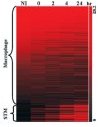Our researchers make fundamental discoveries in biology, chemical and materials sciences, molecular science, atmospheric sciences, and computational sciences and mathematics. Their results will transform the way the world manages its energy and environmental resources in the future.

Northern Exposure
In companion papers published in the Journal of Geophysical Research, a team of U.S., Swiss, and Swedish scientists is revealing new insights about tiny atmospheric particles in the Arctic region, where temperatures are increasing at twice the rate of the rest of the world.
» More

Taking Uranium Down a Notch
Across the country, hundreds of billions of gallons of groundwater are contaminated with uranium from nuclear fuel production, weapons development, and research activities. Scientists have been trying for more than two decades to find ways to safely and cost-effectively prevent that uranium from flowing toward nearby communities.
» More

Are Radiation-Induced Bystander Effects a Universal Phenomenon?
For years, radiation biologists have thought that human DNA is the primary target for energy deposition after exposure to ionizing radiation—such as that from X-rays and gamma rays. However, the discovery of non-targeted responses to radiation, such as the bystander response, has called this paradigm into question.
» More

EMSL's Chinook Supercomputer by HP Commissioned for Research
The newest supercomputer in town is almost 15 times faster than its predecessor and ready to take on problems in areas such as climate science, hydrogen storage and molecular chemistry.
» More

Electron Demolition Derby
Radiation can come in a seemingly benign form like sunlight or in a more destructive form to materials, as in nuclear reactors and outer space. Either way, radiation interacts with the materials it touches. Understanding how those interactions damage or affect the properties of the material has challenged traditional computer modeling and simulation approaches.
» More

Cell Scavengers Look to Take Bite Out of Infectious Disease
Researchers from Pacific Northwest National Laboratory applied a novel global proteomic approach to better understand the extent to which macrophages respond to infection by a form of Salmonella. Recognized as the first global proteomic analyses of time course responses of mouse macrophages to S. enterica serotype Typhimurium (S. Typhimurium) infection, the study may lead to new strategies for diagnosing, treating, and vaccinating against infectious disease.
» More

Studying Bond Formation Between Ions and Surfaces Gets Easier
For the first time, researchers can determine if large molecules and other charged particles that softly land on a surface form the desired bonds, thanks to a new approach built by a team at Pacific Northwest National Laboratory. This method relies on in situ reflection-absorption spectroscopy to monitor the formation of a chemical bond between the ion and the surface.
» More
